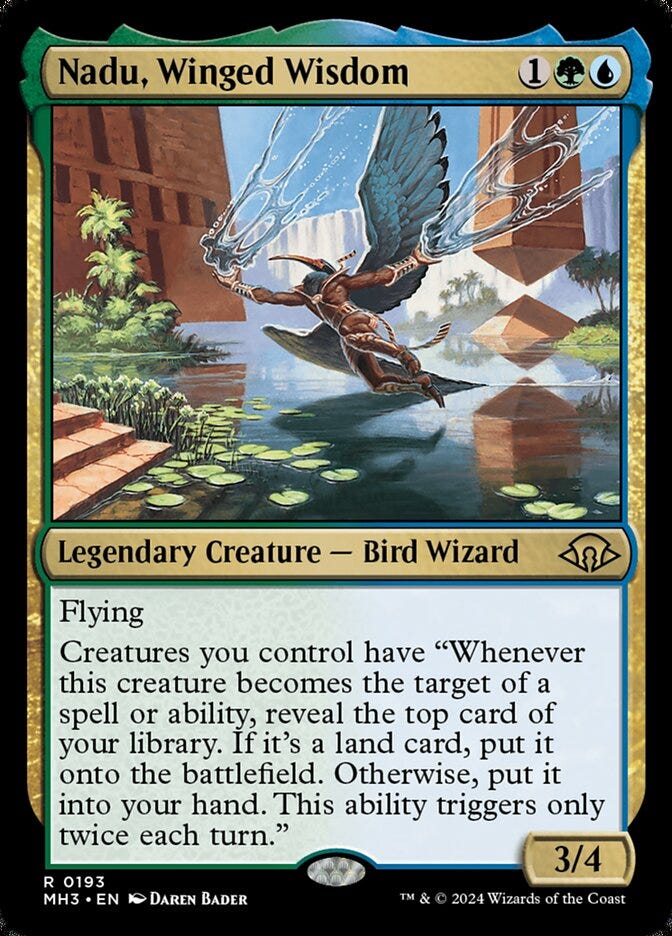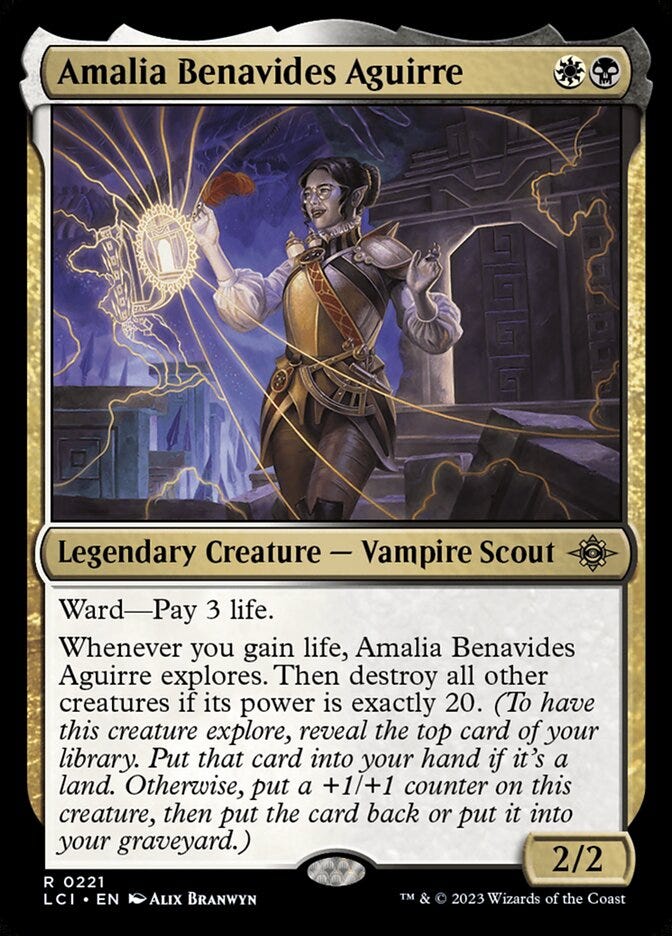fury didn't do anything wrong
on cards and their relationship to archetypes
hi! i’ve decided to start writing about magic, because i think about it a lot, and i would like to get some of the ideas i have down on (digital) paper. don’t expect anything regular. anyways,
i would like to argue the following:
statements of the form “[x card] makes [y archetype] unplayable” are either simply untrue; or true, but not in the way that is intended.
to see what i mean, lets look at a few such statements:
“[sheoldred, the apocalypse] makes [mono red] unplayable”
untrue
“[karn, the great creator] makes [artifact decks] unplayable”
untrue
“[nadu, winged wisdom] makes [necrodominance decks] unplayable”
true, but only because playing nadu, winged wisdom instead is the better choice.
the falsehood of these statements has been self-evident in my eyes for a long time. however, i hadn’t actually examined why statements of this form bother me so much, or what exactly makes them untrue. that is what i intend to do now.
brief aside: i do recognize that part of the time these statements are magic player hyperbole (my greatest enemy). i’m not entirely interested in examining this component however, because i believe that these statements are not always hyperbole, so i will take them at face value going forward.
one card deciding a deck or archetype’s playability implies one of three things to me:
1. this one card is core to [deck a], and [deck a] singlehandedly makes [deck b]’s matchup spread untenable.
2. this one card flips an otherwise favorable matchup for [deck b] against [deck a] and this makes [deck b]’s matchup spread untenable.
3. this one card is so widely played and so good vs a deck or archetype that it ensures that deck or archetype cannot have a good matchup spread.
any of these things being true is hard to believe to me.
1. this one card is core to [deck a], and [deck a] singlehandedly makes [deck b]’s matchup spread untenable.
there are not any good decks that are kept out of the metagame by one matchup. this just doesn’t happen. matchups in magic only get so bad, so to be kept out of the format by one implies that the deck’s winrate outside of that matchup is not impressive to begin with. a bad matchup can be part of the problem, but that’s never the whole story. take as an example, boros convoke in pioneer. i have often heard claims that “[amalia benavides aguirre] makes [boros convoke] unplayable.” this is false.
boros convoke was a deck that prior to the rise of amalia, benefitted from favorable matchups into the format’s top two decks: arclight phoenix, and rakdos midrange. it however, was in a somewhat precarious position due to a highly unfavorable uw control matchup and shifts in how rb midrange was being built. amalia becoming a deck surely did not help convoke, but what’s to say that this matchup is what sank the convoke ship? at the regional championship following the emergence of amalia, boros convoke didn’t have a positive winrate against either of the two decks it was supposed to prey on, phoenix and rakdos, (scoring 50% and 45% respectively) and not only had a terrible winrate vs amalia (19%) but also vs uw control (34%). if convoke had gone 50/50 vs amalia at this event, it would’ve had a sub-50% winrate. did inti, seneschal of the sun make boros convoke unplayable? did teferi, hero of dominaria make boros convoke unplayable? i would argue that these claims are just as sensical as the claim that amalia benavides aguirre made boros convoke unplayable.
2. this one card flips an otherwise favorable matchup for [deck b] against [deck a] and this makes [deck b]’s matchup spread untenable.
this one falls apart for a slightly different reason. this argument applies to what i would call hate cards. it cannot apply to cards that are core to a deck, as that would be covered by point one, and generally the only cards outside of core cards that these claims are being made about are hate cards. maybe someone is out there making the claim that bloodtithe harvester flips the vampires vs lotus field matchup, and ergo bloodtithe harvester makes lotus field unplayable, but i don’t think that’s the case.
hate cards are, as a category, ineffective, or at least less effective than you’d think. the strategy being hated upon often has ways to sidestep or otherwise mitigate the effectiveness of a hate card. these techniques tend to come at the cost of time (not playing too much into a wrath, holding a counterspell up for graveyard hate, fetching to play around blood moon), but the hate cards come at a cost of time to the deck using them as well. with conscious play and deckbuilding, hate cards don’t shift matchups as much as you might expect, especially because they simply won’t show up every game. from this, it follows that a single hate card is highly unlikely to flip a matchup on its own. for this to happen, and that resulting flip of a matchup to cause a deck to go from good to bad, is beyond the realm of possibility in my eyes.
as a quick example of a seemingly devastating but actually underwhelming category of hate card, we can look at boros convoke in otj standard. the obvious hate cards against this deck are sweepers. boros convoke is a deck that wants to use their resources to make a big board, pass the turn, and then attack with it the turn after and kill you. aren’t sweepers like depopulate or path of peril sort of unbeatable? well, the answer is that boros convoke is actually able to fight back against sweepers quite effectively. a cagey style of play, aided by resolute reinforcements providing instant speed plays and knight errant of eos providing cardflow, leads into big turns involving gleeful demolition and imodane’s recruiter that can often make a sweeper into an afterthought. sweepers are still good vs. convoke of course, but they are by no means an end all be all.
3. this one card is so widely played and so good vs a deck or archetype that it ensures that deck or archetype cannot have a good matchup spread.
refuting this falls back on a lot of ideas from point two, so lets look at an example statement.
“[sheoldred, the apocalypse] makes [mono red in standard] unplayable.”
statements like these often overestimate the amount of play the staple sees, how many games it shows up in following that, and its effectiveness in those games. in this case, sheoldred was never the staple people made it out to be in standard. it saw consistent play, but its weakness against a number of top decks, namely esper and domain, severely limited its numbers. even when sheoldred is in a deck, the odds you see it vs mono red aren’t 100%. mono red tends to kill you rather quickly, so you don’t have a lot of time to find your 1-2 copies of sheoldred. even when playing 4, you simply wont see her every game. and then once you’ve put her in your deck and drawn her, your mono red opponent wont simply recoil in horror and concede the game when you cast a card that says “gain life” on turn 4. they have built their deck with sheoldred in mind, and can now answer it in a myriad of ways, or simply ignore her and kill you.
the core problem with these statements is that magic decks interact only with other magic decks, not with cards. what i mean by this is that their playability is decided by winrate, which is decided by matchups, which is decided by other decks. those other decks do contain cards, which effect matchups, but the correlation between a single card and a deck or archetype’s winrate isn’t at all direct, which leads to a host of problems when trying to relate them directly.
so, what’s the point of this whole exploration? does this article actually argue for anything other than saying “erm actually…” when someone says “[x card] makes [y archetype] unplayable?” well, yes. these justifications are often used both to call for bannings and to justify them after the fact. taken directly from the december 4, 2023 banned and restricted announcement is this quote: “Fury, most often played as a 4/4 double striker that clears the opponent's board, makes playing with creature decks nearly impossible.” in my opinion, this statement is nonsensical, and i hope you understand why after reading this article. statements along these lines were often the justifications i heard for banning fury instead of grief to take scam down a peg, or karn instead of nykthos to knock green off the map. in a perfect world, statements like these would not be made anymore, and bannings would not be influenced by them. while we don’t live in a perfect world, i hope that this article shines some light on one of my magic discourse pet peeves, and i hope that after reading this, you will be less inclined to make such statements, or take such statements at face value.
thanks for reading!




